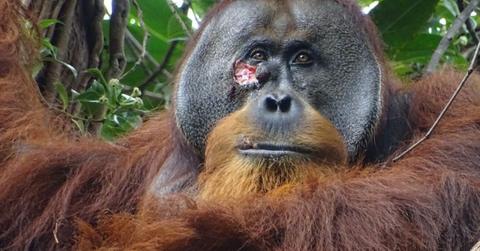Primate Practitioner: Wild Orangutan Spotted Using Medicinal Plant on Flesh Wound for First Time Ever

The wild orangutan was seen using a medicinal plant to help heal a flesh wound, scientists said.
For the first time ever, a wild orangutan has been observed making a paste from a plant with known medicinal properties and applying it to a flesh wound, according to a new study.
In the summer of 2022, researchers from the Max Planck Institute of Animal Behavior in Germany and Universitas Nasional in Indonesia observed a fight between male orangutans at the Suaq Balimbing research site in Indonesia, an area of protected rainforest that is home to around 150 critically endangered Sumatran orangutans.
"During daily observations of the orangutans, we noticed that a male named Rakus had sustained a facial wound, most likely during a fight with a neighboring male,” said Isabelle Laumer, first author of the study published recently in the journal Scientific Reports.
Three days later, Rakus was observed chewing the leaves of a type of liana called Akar Kuning (Fibraurea tinctoria). The climbing vine is not a normal part of the orangutan diet, but it is known to humans to have anti-inflammatory and pain-relieving properties.
Rakus chewed the leaves, then applied the juice to the wound under his eye, before finally applying a paste made of the chewed leaves to cover the wound.
“This and related liana species that can be found in tropical forests of Southeast Asia are known for their analgesic and antipyretic effects and are used in traditional medicine to treat various diseases, such as malaria. Analyses of plant chemical compounds show the presence of furanoditerpenoids and protoberberine alkaloids, which are known to have antibacterial, anti-inflammatory, anti-fungal, antioxidant and other biological activities of relevance to wound healing," Laumer said.
Over the course of the next several days, researchers observed that Rakus' wound did not become infected, and it closed fully after five days.
“Interestingly, Rakus also rested more than usual when being wounded. Sleep positively affects wound healing as growth hormone release, protein synthesis and cell division are increased during sleep,” Laumer said.
- What Lies Beneath: NASA Scientist Believes Aliens May Have Found 'Perfect' Hiding Spot in Earth's Oceans
- Global Threat: Russia Insider Warns West of 'World War Using Nuclear Weapons' Amid Escalating Support for Ukraine
- Countdown to Disaster? Ex-NATO Official Warns Russia, Iran and China Could Wage WWIII in Just Years
“The behavior of Rakus appeared to be intentional as he selectively treated his facial wound on his right flange, and no other body parts, with the plant juice. The behavior was also repeated several times, not only with the plant juice but also later with more solid plant material until the wound was fully covered. The entire process took a considerable amount of time,” Laumer said.
Self-medication does occur in animals, and great apes have been known to ingest certain plants to treat parasite infections. A chimpanzee group in Gabon was recently observed applying insects to wounds, but scientists say the efficacy of that behavior is unknown. Until Rakus, wound treatment with a substance known to be biologically active had not been documented.
Never miss a story — sign up for the Front Page Detectives newsletter. Be on the scene the moment news breaks.
“It is possible that wound treatment with Fibraurea tinctoria by the orangutans at Suaq emerges through individual innovation,” said Caroline Schuppli, senior author of the study. “Orangutans at the site rarely eat the plant. However, individuals may accidentally touch their wounds while feeding on this plant and thus unintentionally apply the plant’s juice to their wounds. As Fibraurea tinctoria has potent analgesic effects, individuals may feel an immediate pain release, causing them to repeat the behavior several times.”
The researchers also noted that, like all the adult males in the area, Rakus was not born in Suaq, and his origins are unknown.
“Orangutan males disperse from their natal area during or after puberty over long distances to either establish a new home range in another area or are moving between other’s home ranges,” Schuppli said. “Therefore, it is possible that the behavior is shown by more individuals in his natal population outside the Suaq research area.”
TMX contributed to this report.
Become a Front Page Detective
Sign up to receive breaking
Front Page Detectives
news and exclusive investigations.
